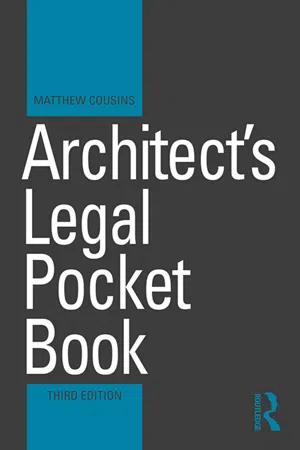
- 396 pages
- English
- ePUB (mobile friendly)
- Available on iOS & Android
Architect's Legal Pocket Book
About this book
A little book that's big on information, the Architect's Legal Pocket Book is the definitive reference guide on legal issues for architects and architectural students. This handy pocket guide covers key legal principles which will help you to quickly understand the law and where to go for further information.
Now in its third edition, this bestselling book has been fully updated throughout to provide you with the most current information available. Subjects include contract administration, building legislation, planning, listed buildings, contract law, negligence, liability and dispute resolution. This edition also contains new cases and legislation, government policy, contract terms and certificates including the RIBA contract administration certificates, inspection duties and practical completion, The Building a Safer Future, Proposals for Reform of the Building Safety Regulatory System Report, the Hackitt review, the Report of the Independent Inquiry into the Construction of Edinburgh Schools and practical issues facing architects.
Illustrated with clear diagrams and featuring key cases, this is a comprehensive guide to current law for architects and an invaluable source of information. It is a book no architect should be without.
Frequently asked questions
- Essential is ideal for learners and professionals who enjoy exploring a wide range of subjects. Access the Essential Library with 800,000+ trusted titles and best-sellers across business, personal growth, and the humanities. Includes unlimited reading time and Standard Read Aloud voice.
- Complete: Perfect for advanced learners and researchers needing full, unrestricted access. Unlock 1.4M+ books across hundreds of subjects, including academic and specialized titles. The Complete Plan also includes advanced features like Premium Read Aloud and Research Assistant.
Please note we cannot support devices running on iOS 13 and Android 7 or earlier. Learn more about using the app.
Information
1
Legal framework
WHAT IS LAW?
CONSTRUCTION LAW
HOW MUCH OF THE LAW IS THE ARCHITECT EXPECTED TO HAVE?
LEGAL RIGHTS AND OBLIGATIONS FOR ARCHITECTS
- The legal framework and applicable laws;
- The roles and identities of the people involved in the project;
- The procurement route adopted;
- Legislation and regulations, in particular building regulations and British Standards;
- Professional codes of conduct.
- The primary basis for the duties owed by an architect is the contract entered into between the parties.9
- It is commonly known that an architect owes a duty to provide the services supplied with reasonable care and skill (section 13 of the Supply of Good and Services Act 1982).
- The standard of reasonable care and skill is not a standard of perfection. It does not make an architect the insurer or guarantor that the work has been properly done. It is not sufficient to prove an error to show that there has been a failure to exercise reasonable skill and care. A claimant must establish actual negligence.10
- An architect is entitled to recommend to a client that the client appoint a third party with the requisite knowledge to carry out work that requires that specialist knowledge. Ordinarily the architect will carry no legal responsibility for the work to be done by the specialist that is beyond the capability of an architect of ordinary competence.11
- An architect’s obligation to supervise or inspect works will depend on various factors including the terms of the retainer, the nature of the works and his confidence in the contractor.12
- A claimant is only entitled to recover any loss and damage caused by the architect’s negligence and that they have sought to mitigate.
- The damage ordinarily recoverable where a building suffers from defects consequent upon the negligence of an architect is the cost of rectification.13
THE LEGAL FRAMEWORK
DIVISIONS OF LAW

COMMON LAW
STATUTE LAW
CIVIL LAW
PRIVATE LAW
PUBLIC LAW
Table of contents
- Cover
- Half Title
- Title Page
- Copyright Page
- Dedication Page
- Contents
- List of figures
- Preface to the third edition
- 1 Legal framework
- 2 Legislation
- 3 Town and country planning
- 4 Land law
- 5 General principles of the law of tort
- 6 General principles of contract law
- 7 Types of construction contracts
- 8 Contract administration
- 9 Dispute resolution
- 10 Design coordination
- Further reading
- Glossary
- Bibliography
- Subject index
- Index of cases
- Index of statutes
- Index of statutory instruments
- Index of European legislation